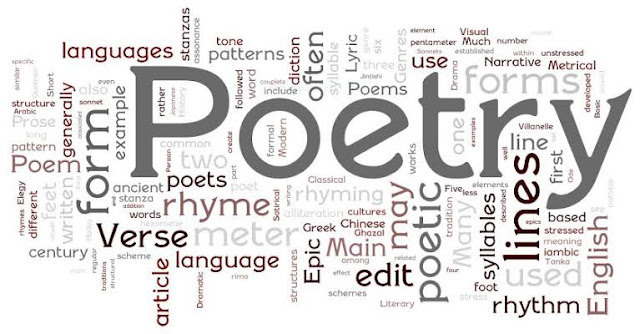ABC OF METER IN POETRY
Meter is the basic rhythmic structure of a line within a work of poetry. Meter consists of two components:
- The number of syllables
- A pattern of emphasis on those syllables
A line of poetry can be broken into “feet,” which are individual units within a line of poetry. A foot of poetry has a specific number of syllables and a specific pattern of emphasis.
Common Types of Feet in Poetry
In English poetry, the most common types of metrical feet are two syllables and three syllables long. They’re characterized by their particular combination of stressed syllables and unstressed syllables. They include:
- Trochee. Pronounced DUH-duh, as in “ladder.”
- Iamb. Pronounced duh-DUH, as in “indeed.”
- Spondee. Pronounced DUH-DUH, as in “TV.”
- Dactyl. Pronounced DUH-duh-duh, as in “certainly.”
- Anapest. Pronounced duh-duh-DUH, as in “what the heck!” (Anapestic poetry typically divides its stressed syllables across multiple words.)
Common Types of Meter in Poetry
Metrical feet are repeated over the course of a line of poetry to create poetic meter. We describe the length of a poetic meter by using Greek suffixes:
- one foot = monometer
- two feet = dimeter
- three feet = trimeter
- four feet = tetrameter
- five feet = pentameter
- six feet = hexameter
- seven feet = heptameter
- eight feet = octameter
Examples of Meter in Poetry
When you combine the stress patterns of specific poetic feet with specific lengths, you unlock the many possibilities of poetic meter. A good example of this is “iambic pentameter,” which can be found in English language poetry across many centuries.
Iambic pentameter contains five iambs per line, for a total of ten syllables per line. Every even-numbered syllable is stressed. William Shakespeare is the most famous practitioner of iambic pentameter in the English literary canon. Each of Shakespeare’s 154 sonnets features rhyming iambic pentameter—specifically adhering to an ABAB CDCD EFEF GG pattern.
Those lips that Love's own hand did make Breathed forth the sound that said 'I hate' To me that languish'd for her sake; But when she saw my woeful state, Straight in her heart did mercy come, Chiding that tongue that ever sweet Was used in giving gentle doom, And taught it thus anew to greet: 'I hate' she alter'd with an end, That follow'd it as gentle day Doth follow night, who like a fiend From heaven to hell is flown away; 'I hate' from hate away she threw, And saved my life, saying 'not you.'




Comments
Post a Comment